
| Readings: |
Rationalism Geocentric Cosmology Ptolemy |
Rationalism:
Science, it is widely agreed, originated from two main sources. One was the need to develop practical knowledge and to pass it from generation to generation. The other was a more spiritual concern with the nature and origin of the world. Common to both of these well-springs of science was an appreciation of the regularity of Nature. One of the first scientists to make frequent use of the concept of a law of Nature, in the sense that we now use that term, was the Franciscan friar and scholar Roger Bacon (c. 1214-1292).

The earliest beginnings of science was to note that there exist patterns of cause and effect that are manifestations of the Universe's rational order. We mostly develop this idea as small children (touch hot stove = burn/pain). But the extrapolation of a rational order to cosmology requires a leap of faith in the beginning years of science, later supported by observation and experimentation.
Thus, the main purpose of science is to trace, within the chaos and flux of phenomena, a consistent structure with order and meaning. This is called the philosophy of rationalism. The purpose of scientific understanding is to coordinate our experiences and bring them into a logical system.

Thoughout history, intellectual efforts are directed towards the discovery of pattern, system and structure, with a special emphasis on order. Why? control of the unpredictable, fear of the unknown, and a person who seeks to understand and discover is called a scientist.
Science is founded on the hope that the world is rational in all its observable aspects. Its possible that there may be some facets of reality which lie beyond the power of human reasoning, that there may be things with explanations that we could never grasp, or no explanation at all, but the fact that the world is rational is connected with the fact that it is ordered.
Eratosthenes:
Between the cosmological foundation set by the Presocratics and the world of Ideas introduced by Plato was a set of fundamental calculations on the size of the Earth, Moon, Sun and the distances between the nearby planets performed by Eratosthenes and Aristarchus (c. 250 BC). Using some simple geometry, these two natural philosophers were able to, for the first time, place some estimate of the size of the cosmos in Earth terms.
For a long time it was realized that the earth's surface was curved by people familiar with the behavior of incoming and outgoing ships. For it was obvious that as a ship passed over the horizon, the hull disappeared first, then the topmost sailing masts (although one could argue this is an effect of refraction in the atmosphere). Ancient astronomers could see with their eyes that the Sun and the Moon were round. And the shadow of the Earth, cast on the lunar surface during a lunar eclipse, is curved. A sphere is the simplest shape to explain the Earth's shadow (a disk would sometimes display a shadow shaped like a line or oval).
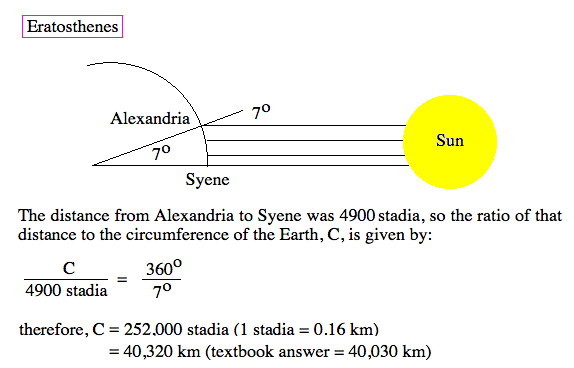
Geometric Cosmology:
There were only seven objects visible to the ancients, the Sun and the Moon, plus the five planets, Mercury, Venus, Mars, Jupiter and Saturn. It was obvious that the planets were not on the celestial sphere since the Moon clearly passes in front of the Sun and planets, plus Mercury and Venus can be seen to transit the Sun. Plato first proposed that the planets followed perfect circular orbits around the Earth. Later, Heraclides (330 B.C.) developed the first Solar System model, placing the planets in order from the Earth it was is now called the geocentric solar system model.
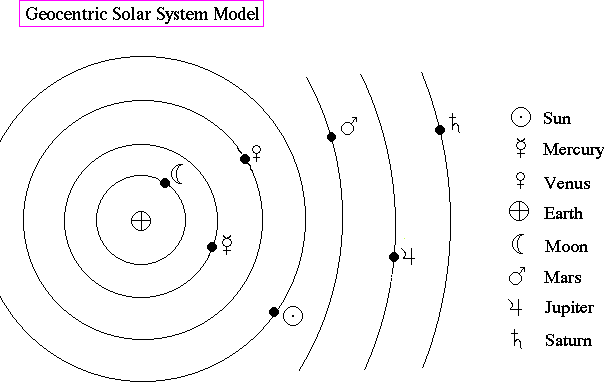
Slightly later, Aristarchus (270 B.C.) proposed an alternative model of the Solar System placing the Sun at the center with the Earth and the planets in circular orbit around it. The Moon orbits around the Earth. This model became known as the heliocentric theory
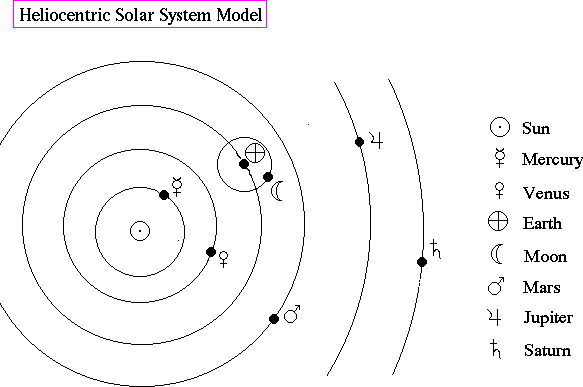
Problems for Heliocentric Theory:
While today we know that the Sun is at the center of the solar system, this was not obvious for the technology of the times per-1500's. In particular, Aristarchus' model was ruled out by the philosophers at the time for three reasons:
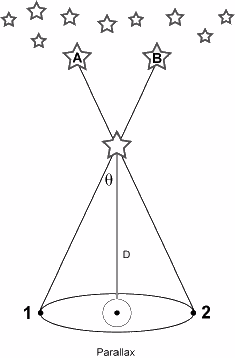
Of course, if all the stars are implanted on the crystal celestial sphere, then there is no parallax.
Ptolemy:
Ptolemy (200 A.D.) was an ancient astronomer, geographer, and mathematician who took the geocentric theory of the solar system and gave it a mathematical foundation (called the "Ptolemaic system"). He did this in order to simultaneously produce a cosmological theory based on Aristotle's physics (circular motion, no voids, geocentric) and one that would provide a technically accurate description of planetary astronomy. Ptolemy's system is one of the first examples of scientists attempting to "save the phenomena", to develop a combination of perfect circles to match the irregular motion of the planets, i.e., using concepts asserted by pure reason that match the observed phenomenon.
Ptolemy wrote a great treatise on the celestial sphere and the motion of the planets call the Almagest. The Almagest is divided into 13 books, each of which deals with certain astronomical concepts pertaining to stars and to objects in the solar system. It was, no doubt, the encyclopedic nature of the work that made the Almagest so useful to later astronomers and that gave the views contained in it so profound an influence. In essence, it is a synthesis of the results obtained by Greek astronomy; it is also the major source of knowledge about the work of Hipparchus.
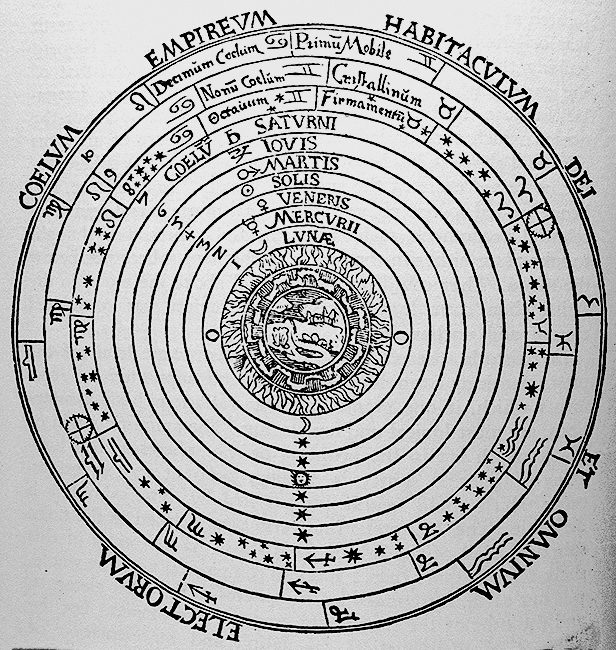
The Christian Aristotelian cosmos, engraving from Peter Apian's Cosmographia, 1524
In the first book of the Almagest, Ptolemy describes his geocentric system and gives various arguments to prove that, in its position at the center of the universe, the Earth must be immovable. Not least, he showed that if the Earth moved, as some earlier philosophers had suggested, then certain phenomena should in consequence be observed. In particular, Ptolemy argued that since all bodies fall to the center of the universe, the Earth must be fixed there at the center, otherwise falling objects would not be seen to drop toward the center of the Earth. Again, if the Earth rotated once every 24 hours, a body thrown vertically upward should not fall back to the same place, as it was seen to do. Ptolemy was able to demonstrate, however, that no contrary observations had ever been obtained.
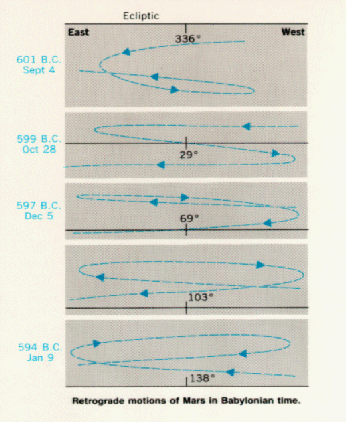
Ptolemy accepted the following order for celestial objects in the solar system: Earth (center), Moon, Mercury, Venus, Sun, Mars, Jupiter, and Saturn. However, when the detailed observations of the planets in the skies is examined, the planets undergo motion which is impossible to explain in the geocentric model, a backward track for the outer planets. This behavior is called retrograde motion.
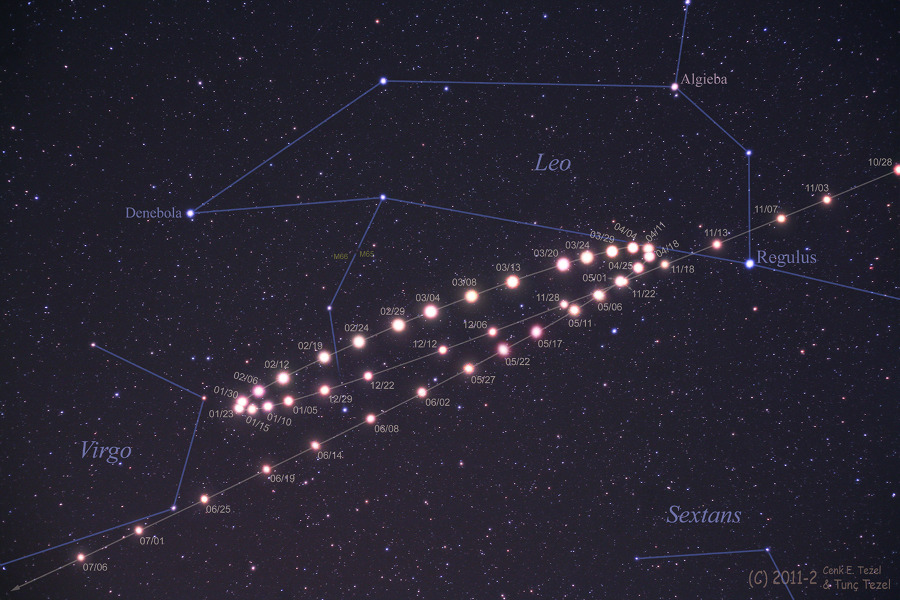
He realized, as had Hipparchus, that the inequalities in the motions of these heavenly bodies necessitated either a system of deferents and epicycles or one of movable eccentrics (both systems devised by Apollonius of Perga, the Greek geometer of the 3rd century BC) in order to account for their movements in terms of uniform circular motion.
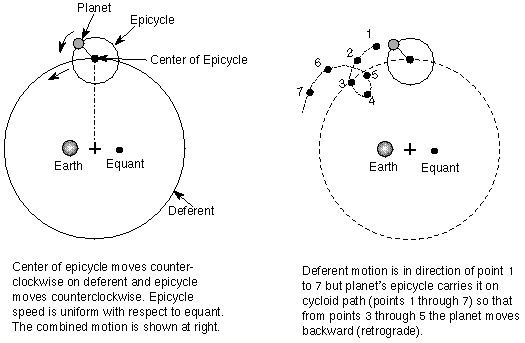
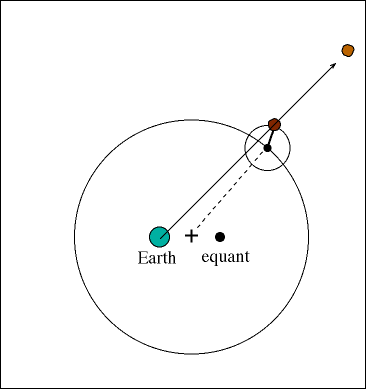


Mathematics and Cosmology
At the end of the Greek era, there is no doubt that we completed our transition from mythical, supernatural explanations of cosmology to a natural, science based description. And, it is clear, that the mathematical description of the cosmos given by Ptolemy is, in the words of the mathematical Wigner, "unreasonably effective", meaning that is mathematics is a surprisingly successful to understand the natural world, beyond our expectations given the chaos that reigns in everyday phenomenon. This is the ultimate verification of the Greek philosophical tradition which asserts that nature is understandable rather than under the control of capricious deities which are to be appeased rather than understood, is one of the roots of science. Thus, the greatest gift from the Greek was the philosophy of rationalism, that the Universe is open to inspection and, ultimately, understandable.
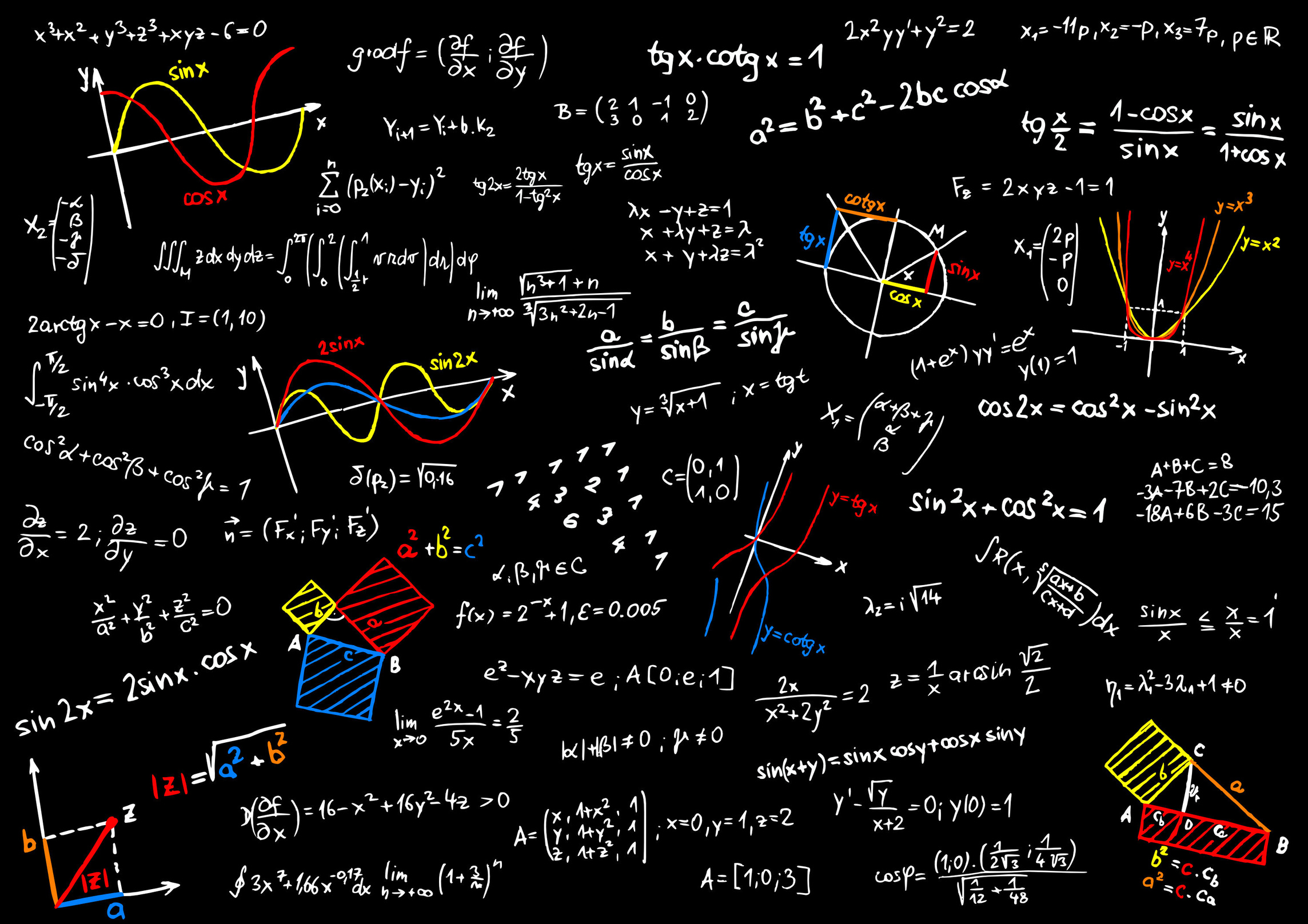
Philosophy is written in this grand book, the Universe which stands continually open to our gaze. But the book cannot be understood unless one first learns to comprehend the language and read the letters in which it is composed. It is written in the language of mathematics, and its characters are triangles, circles and other geometric figures without which it is humanly impossible to understand a single word of it; without these, one wanders about in a dark labyrinth.
It is of continuing amazement, to both scientists and philosophers alike, that the laws of Nature can be expressed in mathematical form, and that humans are capable of processing that kind of math. However, while no one doubts the importance of mathematics to science, there is a continuing debate on the origin of math's effectiveness. On one hand, we see Plato's belief that mathematical ideas exist independent of our world, or human thought (the realist or Platonism view). In fact, for Plato, the real world is this mathematical world, not the shadow, physical world we live in. Aristotle, on the other hand, believes that math is a human invention, and that the mind is where math is created (the instrumentalist or formalist view). Humans created mathematics by idealising or abstracting elements of the physical world. In fact, mankind's extraordinary math abilities may simply be the product of millions of years of evolution providing us with powerful intellectual tools as a survival asset.
A modern view of mathematics and science is provided by Bertrand Russell who states "Mathematics is the chief source of the belief in eternal and exact truth, as well as a sensible intelligible world". This is a guiding principle for most scientists and mathematics. Scientists do create methods to quantify phenomenon in physics, chemistry and biology, and these inventions are effective. However, it should be remembered is that these mathematical methods are, in many cases, incredible accurate. So as phenomenon is studied and recorded, and as patterns emerge (via the scientific method), humans will take mathematical concepts from abstracting elements and apply them to problems. But the discovery is in the connections to science, not the mathematical objects themselves.
The bottom line about the relationship of mathematics to science is basically that math works. Mathematics is very much a part of the Universe and very necessary for understanding cosmology. For we will see, in later chapters, that there are properties to the Universe can only be understood through mathematics. For example, our senses and mental models are fixed in a three dimensional world (3D), and the macroscopic Universe is the four dimensional (4D) construct called spacetime. To explore spacetime requires an extension to our senses that only mathematics provides.
The mathematics of the Greeks was geometry and arithmetic, but as we advance forward in the history of cosmology we will encounter more sophisticated mathematics. Newton will introduce calculus, the math of infinitesimals. Einstein will introduce non-Euclidean geometry. Quantum physics uses differential equations and matrix algebra. These math methods are the windows in which we see, and understand, reality. By the 21st century, we will see a heavy usage of computers and artificial simulations to probe the vast amount of information provided by new technologies. And our sense of how we do science will change as encounter new concepts which are not testable in the traditional sense of direct observation or experimentation.
However, common to all cosmological investigations from the Greeks to modern times was an appreciation of the regularity of Nature. That Nature has, within itself, mathematical patterns that could be expressed as laws of Nature (the law of gravity, the law of conversation of energy, the Ideal Gas law, etc.). The idea that physical entities obey laws is a strictly Western invention for Eastern cultures would find it absurd for inanimate objects "understanding" laws.
Middle Ages
The period between the fall of the Roman Empire and the start of Renaissance in the 14th century is known as the Dark or Middle Ages. While the Middle Ages were considered a time of scientific stagnation due to the recurring political and social upheavals of the time, their was a continued steady progress in intellectual thought in Europe and surrounding kingdoms in the Mideast and India. While the Catholic Church dominates most knowledge enterprises during this era, their influence was not as suppressive as popularly portrayed and various Church institutions were mostly responsible for the preservation of cosmological ideas from the Greeks.
The distinction between what makes up matter (the primary elements) and its form became a medieval Christian preoccupation, with the sinfulness of the material world opposed to the holiness of the heavenly realm (which is interesting since modern cosmology is heavily consumed with the issue of dark matter). The medieval Christian cosmology placed the heavens in a realm of perfection, derived from Plato's Theory of Forms
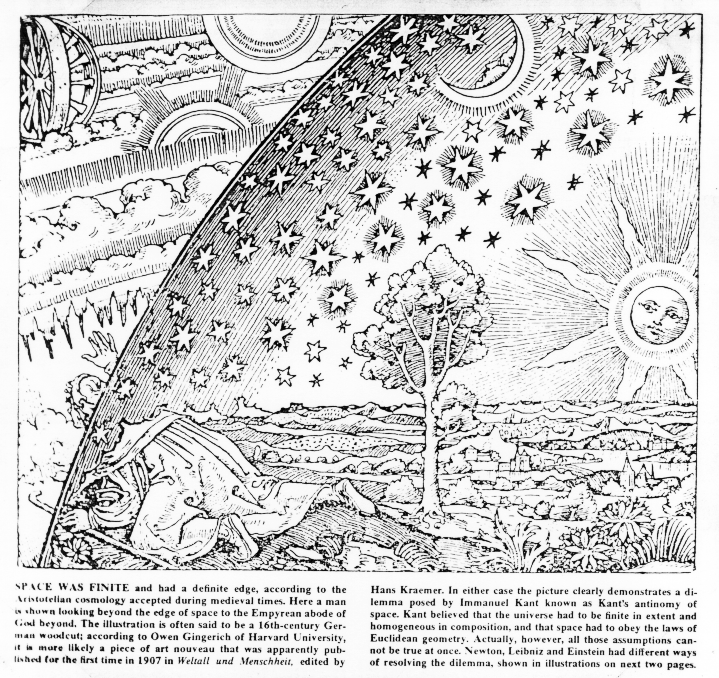
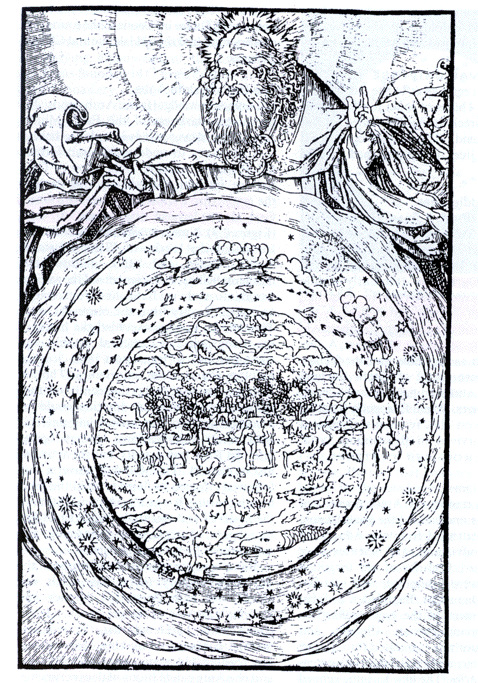
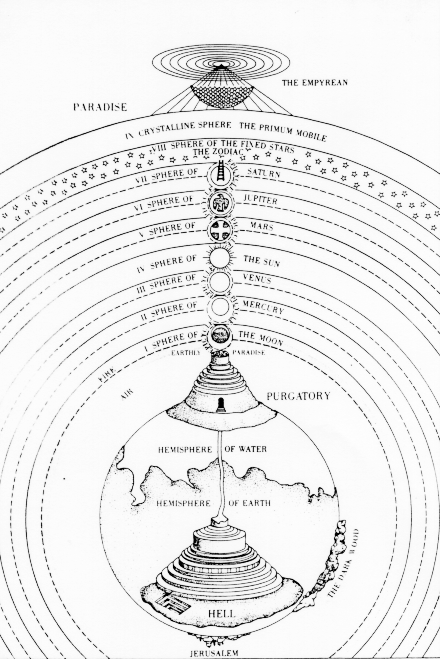
Dante's cosmology is divided into three sections, based on theological doctrine, Inferno (Hell), Purgatory and Paradise. The physical layout is such that Lucifer defines the very center of the Universe and God is found in the outer region. Inside the Earth is found Hell, divided into nine circles for increasing levels of sin. Between the surface of the Earth and sphere of the Moon lies Purgatory (a mountain divided into seven terraces, displaced from the Earth when Lucifer fall created Hell).
Above Purgatory lies the spheres of Heaven, each describing a deficiency in one of the cardinal virtues. The Moon, containing the inconstant, whose vows to God waned as the moon and thus lack fortitude; Mercury, containing the ambitious, who were virtuous for glory and thus lacked justice; and Venus, containing the lovers, whose love was directed towards another than God and thus lacked Temperance. The final four incidentally are positive examples of the cardinal virtues, all led on by the Sun, containing the prudent, whose wisdom lighted the way for the other virtues, to which the others are bound (constituting a category on its own). Mars contains the men of fortitude who died in the cause of Christianity; Jupiter contains the kings of Justice; and Saturn contains the temperant, the monks who abided to the contemplative lifestyle.
Despite the main focus on religious concepts in the 'Divine Comedy', a great deal of physical cosmology is outlined that merges religious doctrine of the time into the Ptolemaic system with scientific additions that parallel the discoveries from the time of Aristotle. For example, there are numerous references to a spherical Earth and changing constellations with latitude and varying timezones. The connection between the supernatural and the physical in Dante's cosmology mimics the Platonic viewpoint of the physical world being a copy of the world of Forms. Here the planetary spheres copy the angelic hierarchies that rotate around God (and the circles of Hell are a parody that rotates around Satan). Even the geocentric Universe is simply an imperfect copy of the spiritual form of Paradise, a theocentric Universe where the angels that power the motion of the planets are actually revolving around God, who illuminates all things from the center. With perfect symmetry in both physical and theological space, Dante's cosmology represents the peak in medieval cosmology blending the Ptolemaic system with Christian doctrine.
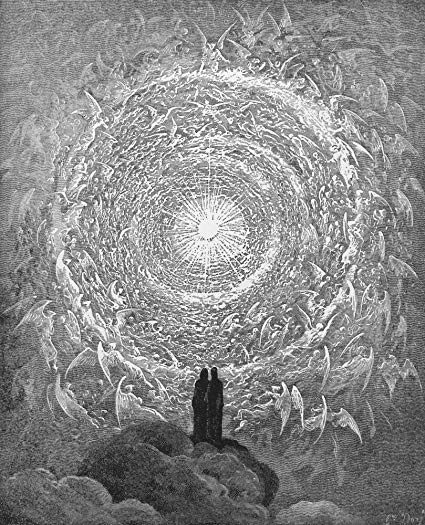
Since cosmology involves observations of objects very far away (therefore, very faint) advancement in our understanding of the cosmos has been very slow due to limits in our technology. This has changed dramatically in the last few years with the construction of large telescopes and the launch of space-based observatories.
Copernicus:
As we know from history, the great library at Alexandria burns in 272 AD, destroying a great deal of the astronomical data for the time. Roman culture collapses and we enter the Dark Ages. But, the Roman Catholic Church absorbs Aristotle's scientific methods and Ptolemy's model into its own doctrine. Thus, preserving the scientific method and Ptolemy's Solar System. Unfortunately, the geocentric model was accepted as doctrine and, therefore, was not subjected to the scientific method for hundreds of years.
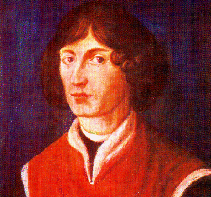

While Copernicus includes a rotating Earth in his heliocentric model, he continues to cling to Aristotle's celestial motions, i.e. orbits that are perfect circles (rather than their true shape, an ellipse). This forces Copernicus to adopt a series of moving sphere's for each planet to explain longitude motion. While Copernicus has fewer sphere's, since more of the retrograde motion is accounted for, his system is still extremely complicated in a computational sense. It's two greatest advantages is that it places the inferior planets near the Sun, naturally explaining their lack of large eastern or western elongations, and removing any extreme motions, such as that needed to explain durnal changes.
Copernicus also changes the immovable empyrean heaven into a fixed sphere of stars, severing theology from cosmology. However, Copernicus fails to produce a mechanically simple scheme for astrologers to cast horoscopes or astronomers to produce almanacs, for ultimately the tables he produces are as complicated as Ptolemy's and he did not publish all his results in the final edition of his work, "On the Revolutions of the Heavenly Spheres".
However, Copernicus, like Ptolemy, also used circular orbits and had to resort to epicycles and deferents to explain retrograde motions. In fact, Copernicus was forced to use more epicycles than Ptolemy, i.e. a more complicated system of circles on circles. Thus, Copernicus' model would have failed our modern criteria that a scientific model be as simple as possible (Occam's Razor).
Planetary Configurations:
The planets outside of the Earth's orbit (Mars, Jupiter, Saturn, Uranus, Neptune, Pluto) are called superior planets
Likewise, the planets inside of the Earth's orbit (Mercury, Venus) are called inferior planets.


|
|

|